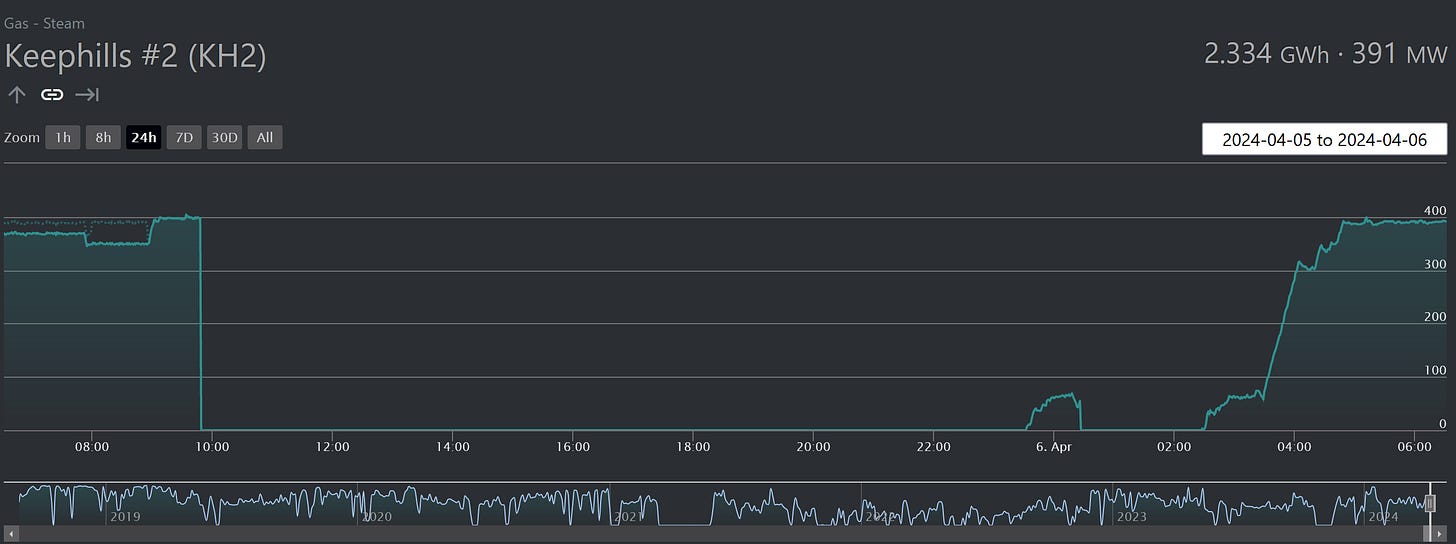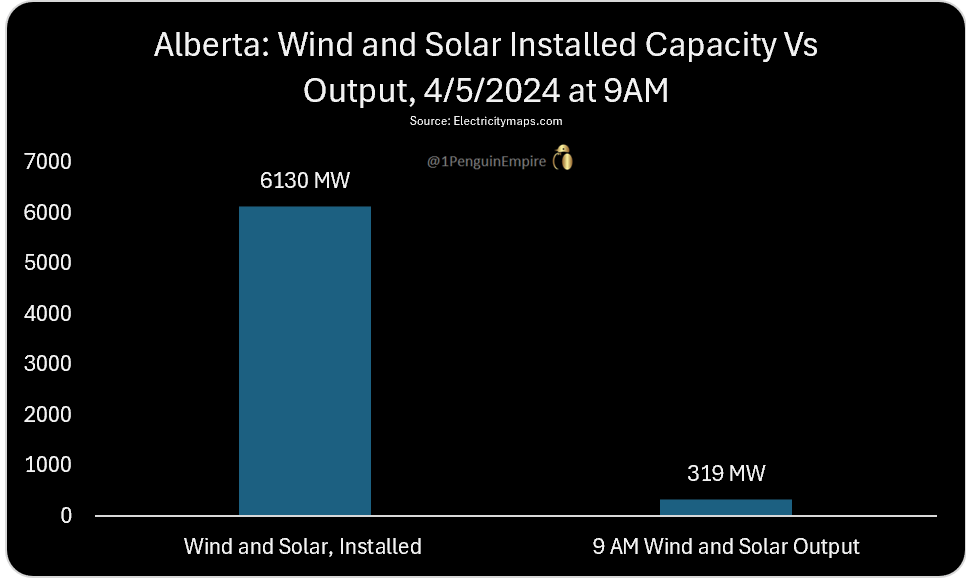Thousands Go Without Power During Alberta's "Brownout"
On Friday, April 5th, 2024, Alberta's grid ran out of available generating capacity, resulting in power-outages during a snowy spring morning.
While spring can mean flowers and sunshine for some, in Alberta, spring can still mean snow and freezing temperatures. While much of Alberta was waking up on Friday, April 5th 2024, temperatures were just below freezing (approx -1C), with cloudy skies, light snow, and very low wind speeds. Here’s a screen shot of weather data from the Edmonton International Airport weather station.
Around the same time, Alberta’s grid operator (AESO) issued a grid alert - the second for the week - at 6:49am, warning that supply was ‘tight’ and requested that customers conserve electricity.
Conditions rapidly deteriorated on the grid. Between ~ 8:53 and 9:16 am, Alberta’s grid could not meet electricity demand. There simply were not enough available generators online so the grid had to load-shed, resulting in power outages for a rather rude awaking for thousands of residents. According to CBC news:
“Enmax turned off power to about 25,000 Calgary customers for about 14 minutes…Epcor shut off power to about 20,000 customers across Edmonton for less than 30 minutes… (and) about 15,000 customers in rural areas lost power, from the northeastern community of Conklin to the southern Alberta hamlet of Skiff.”
These power outages weren’t the result of a tree branch falling onto a transmission line or a drunk driver taking out a transformer.
So what happened?
Let’s set the stage…
For those not familiar, a grid operator is like a wedding planner who estimates demand (how many guests) and supply (how big of a church is needed). The grid operator (wedding planner) then tries to coordinate enough resources to be available at the right time.
On top of the estimated demand, grid operators like to have a margin of safety, and have some capacity standing by just in case one of the power plants breaks and goes offline or if demand is a little bit higher than expected.
Capacity that is not scheduled to cover demand (or act as a reserve) can go offline for maintenance or shut off for a later date. Typically in the spring, demand for electricity is lower than the winter or summer. So, many plant operators schedule ahead of time for the plant to be offline in the spring.
And just before the lights went out, Alberta had over 3000MW of gas plants offline for maintenance or idling due to low expected demand. That’s out of a fleet of ~ ~12,246MWs, so ~ 25% + of the fleet was offline. Those offline gas plants included:
Cascade 2, a newly constructed 450MW gas plant that still hasn’t come online for the first time yet
Shepard Gas Plant, a major ~881 MW gas plant that was offline for scheduled maintenance
Sundance Gas, a 401MW Steam power plant that had been offline since April 2nd
Battle River 5, a gas steam plant 395 MW, also offline since April 3rd
It’s a similar story with Alberta’s coal power plants. The province only has two coal units: Genesse #1 & 2 with a combined capacity of approx 820MW. The owner/operator of the units announced that it is planning to replace both coal units with natural gas combined cycle units later this year. So it is no surprise that shortly before the outages one of the units (Genesse #2 ~420MW) was offline and not producing power for the grid.
Wind’s “Cliffs” and “Leverage”
A wind turbine’s output is highly sensitive to wind speeds. Wind speed is a bit like a pry bar used as a lever. If you put a little bit more pressure on the end of the pry bar, it can exert a lot more pressure at the other end. In general, if wind speed goes up by 2x, the potential power in wind goes up by 8x. It goes the other way as well and if the wind speed drops in 1/2, the power potential goes down to 1/8th.
Plus there has to be a minimum amount of wind to get those rotors (often 300 feet + in diameter) to spin. That minimum speed (known as the ‘cut-in’ speed) can vary depending on the type of turbine, but many turbines need 6-9mph wind (~10-14.5 kph) to ‘cut-in.’
Because weather fronts can be very large, changes in wind speeds tend to impact a large region, at the same time. So if a ‘wind drought’ settles over a region, you might have turbines slowly turning at just above the ‘cut-in’ point. But those turbines are sitting on the knife’s edge and if the wind goes any lower, the turbines output stops and you can see a large number of wind farms fall off that ‘cliff’ around the same time.
Things Quickly Fell Apart For Alberta.
After the outages, AESO held a Zoom press conference, which you can watch here. AESO’s Vice President of Grid Reliability, Marie-France Samaroden, delivered prepared remarks and then answered media questions. According to her, on April 4th (the night prior), AESO forecast that it could meet demand and still have 800MW of extra capacity standing by as a ‘margin of error.’
For reference, AESO’s estimated ‘reserve’ capacity of 800 MW was about 8% of expected demand. So, AESO thought it had enough power plants ready to cover ~ 108% of the expected demand on Friday morning.
However, Alberta’s grid operator was counting on wind showing up, but it didn’t as it plunged ~75%.
“The wind generation that materialized was 900 MW below forecast” Samaroden explained. That means AESO’s forecast depended on approximately 1100-1300 MW of wind power for Friday morning but instead, Alberta got ~ 300MW of wind at 9am.
That dramatic drop in wind effectively wiped out the grids margin of error. Nothing else could go wrong, but it did.
Just before 9 am Alberta time (10 am central time on the chart from dispatcho) the Keephill #2 gas unit “tripped,” and ripped a 395MW generation “hole” in the grid. Notice that right before Keephill #2 tripped, it was running at or slightly over its rated capacity (~395mw).
To plug the gaps in the grid, the AESO scrambled to find available generators to make unscheduled returns to the grid.
One of the units called on was the Genesee #2 coal plant. However, it took time to ramp up the plant.
While Alberta’s grid may have scraped by if only the wind had dropped or if only the gas plant had tripped, it couldn’t handle both. In fact, the drop in wind was basically equivalent to 2 gas plants going offline. Then when an actual gas plant went offline, Alberta’s grid couldn’t handle the strain. The grid shed 250MW of load, resulting in power outages.
Here’s a chart of the capacity utilization of various Alberta plants based on installed capacity, including plants offline for maintenance or still under the final stages of construction/outfitting.
At 9am during the middle of the crisis, Alberta’s gas plants operated fleet wide at ~59% capacity, and coal at ~47%. Coal ramped up and by noon, coal was operating at ~ 99% utilization.
Wind failed to live up to the forecast, even when the expectation was already low. The day before, AESO expected wind to perform at 25-30% of installed capacity. Instead, that bar was set too high and at 9am, wind capacity was only at ~ 7%.
And it didn’t help that it was a cloudy snowy morning, keeping most of the solar offline until much later in the day.
All together, Alberta has approximately 6130MW of installed wind and solar. Yet during the outages Friday morning, at 9am, wind and solar combined only produced ~ 319 MW or at just ~ 5% of it’s capacity.
Alberta’s Grid Operator rolled the dice and bet that it could rely on wind showing up. When it didn’t, the grid effectively had no margin of error - nothing else could go wrong. But just like Murphy’s Law, it did when a gas plant tripped offline.
A reliable grid should be built to have enough reliable capacity to easily handle any one plant going unexpectedly offline. But when your margin of error can literally disappear with the wind, you’re betting against mother nature.
We’ll close with a quote from the Energy Bad Boys from a recent piece titled Wind Drought Blackout: Do You Feel Lucky, Punk?
The wind isn’t always blowing somewhere. Any system that relies on wind and solar to meet demand will face this reality head-on and risk its reliability.
As always, thanks for reading!










Depending on wind and solar is like planning an outdoor wedding without a large enough backup indoor venue.
“Enmax turned off power to about 25,000 Calgary customers for about 14 minutes…Epcor shut off power to about 20,000 customers across Edmonton for less than 30 minutes…"
Reminds me of the time my wife was visiting a 3rd world country, El Salvadore, and the power was on and off every day. Never thought we'd see any similar operational problems in America or Canada.